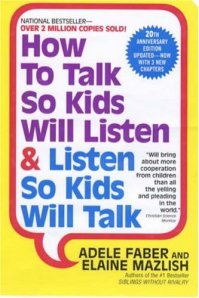8 Jan 2009
Listening Lessons from a Grand Book about Parenting
 Over the past several months I have been reviewing several popular books on listening. And in the course of my reading, I have come across a wonderful book called “How to Talk So Kids Will Listen and Listen So Kids Will Talk” by Adele Faber and Elaine Mazlish. Although I don’t have children, I find this book to be a refreshing view on the topics of growth and helping.
Over the past several months I have been reviewing several popular books on listening. And in the course of my reading, I have come across a wonderful book called “How to Talk So Kids Will Listen and Listen So Kids Will Talk” by Adele Faber and Elaine Mazlish. Although I don’t have children, I find this book to be a refreshing view on the topics of growth and helping.
The ideas in “How to Talk So Kids Will Listen…” resonate for me because they are grounded in principles of respect for and empowerment of others, as is Supportive Listening. The authors point out how well meaning parents can habitually deny children their feelings, as illustrated by the example of a parent who says to a child, “You couldn’t be tired, you just napped.”
In their book Faber and Mazlish offer a way to listen carefully, acknowledge what the child is saying, and then help the child to name the feeling that they are experiencing. Although guessing and naming the feelings of the speaker isn’t part of Supportive Listening, I could see such a technique could being useful in listening to children, particularly young children.
“How to Talk So Kids Will Listen…” has a whole chapter on how to encourage autonomy in children. Of the six pointers that they give, I found three of them to be extremely valuable in encouraging autonomy in anyone, not just children.
- Show autonomy for the child’s struggle. It can be difficult to be present to the struggle of somebody who I care about. And yet out of struggle comes learning and growth. By not taking away that struggle, I leave room for the growth to happen.
- Don’t ask too many questions. While open-ended questions can be helpful to invite somebody to get clarity into their challenge, too many questions becomes an inquisition. When I ask too many questions, the process becomes one of me as a listener troubleshooting, as opposed to they as speaker thinking and exploring.
- Don’t rush to answer questions. As someone is thinking through their challenge, they will often say a question out loud. But it doesn’t mean that they are actually asking me, and that I need to answer it. I love to put the question back to the person, by simply saying “What do you think?” And I am surprised by how often they come up with an answer to their own question that is new, that they hadn’t thought of before.
This chapter on autonomy has a special section specifically about advice. In Supportive Listening workshops I am sometimes asked “What’s the problem with giving advice?” I think that advice can be a useful tool in specific scenarios, but is vastly overused and carries risks. Faber and Mazlish nicely summarize these risks:
When you give immediate advice to children, they either feel stupid (” Why didn’t I think of that myself?”), resentful (“Don’t tell me how to run my life!”), or irritated (“What makes you think I didn’t think of that already?”).
and the upsides of listening:
When a child figures out for herself what she wants to do, she grows in confidence and is willing to assume responsibility for her decision.
As listeners, we have the potential to support growth and learning in those around us.
“How to Talk So Kids Will Listen…” has a very novel feature: the use of two to four panel cartoons to illustrate the key concepts. Each concept has one cartoon to show the old problematic parent-child interaction, and another to show the new interaction that results from using the concept. From these nicely illustrated everyday scenarios, I quickly got the main ideas, and in fact by flipping through these for each chapter, was able to get a decent overview of the whole book. It’s a fantastic teaching tool.
[If you want to see these online, you can do so if you log into the Barnes and Noble page for this book. Click “See Inside,” search for the word “feelings” and read from page 9 to page 13.]
Each chapter in the book is nicely rounded out with interactive exercises, written practice, real-life stories, and questions and answers.
If you’re interested in learning more about this book, you can browse through excerpts for free on Harper Collins website, or find it at your local library.
